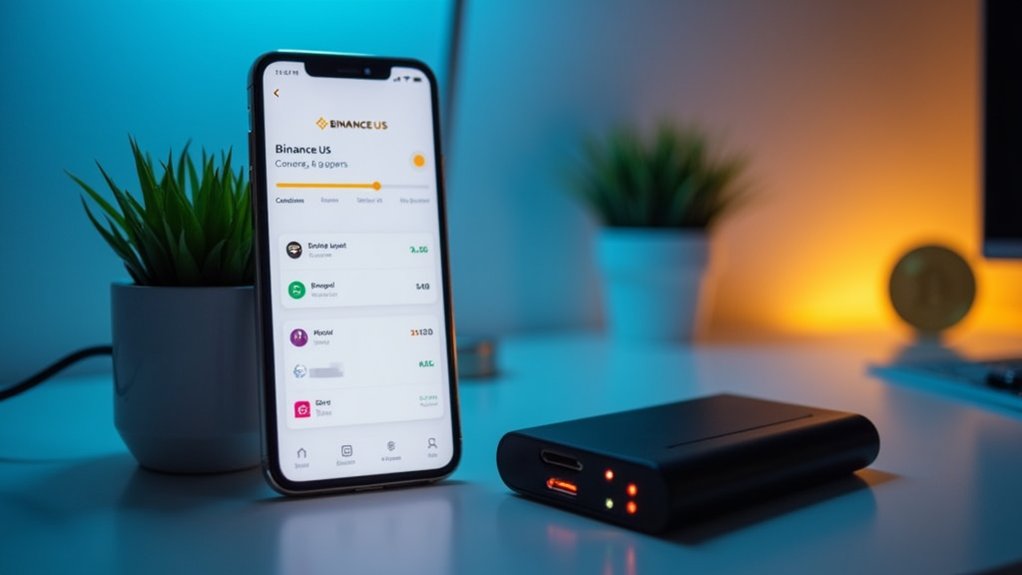Selling cryptocurrency requires completing several key steps to convert digital assets into fiat currency. Investors must first verify their identity through KYC procedures, select the cryptocurrency to liquidate, and choose a withdrawal method like bank transfer or card payment. Transaction fees vary greatly, from 1% for bank transfers to 4.5% for card withdrawals, while network fees remain constant regardless of method. Capital gains taxes typically apply to profits, necessitating thorough record-keeping for compliance. Further exploration reveals additional strategies to maximize returns while reducing costs.

Converting cryptocurrency holdings back into fiat currency represents a critical phase in the investment cycle, one that requires strategic planning and awareness of various market mechanisms. When investors decide to liquidate their digital assets, multiple pathways exist, including Visa/Mastercard withdrawals available in over 80 countries for instant cashouts, global bank transfers with local currency conversion capabilities, and specialized services like MoonPay Balance which enables zero-fee transactions.
The incorporation of traditional financial infrastructure, exemplified by PayPal connectivity, further expands accessibility options while regional variations accommodate specific jurisdictional requirements. MoonPay supports selling over 120 cryptocurrencies including popular options like Bitcoin, Ethereum, and Solana. Cryptocurrency exchanges like Coinbase or Binance offer straightforward methods to sell digital assets and withdraw funds directly to bank accounts.
Transaction costs warrant careful consideration, as they greatly impact net returns on cryptocurrency investments. Bank transfers typically incur fees as low as 1%, whereas card payments may reach 4.5% due to additional processing requirements. Users seeking maximum value retention often utilize zero-fee options like MoonPay Balance, though foundational blockchain network fees remain outside platform coverage regardless of withdrawal method.
Transaction fees can significantly erode cryptocurrency profits, making fee-conscious withdrawal method selection essential for maximizing investment returns.
These financial mechanics must be evaluated alongside potential tax consequences that vary by jurisdiction. Successful platforms like Coinbase offer detailed guides that explain crypto selling processes in accessible Q&A formats for better search engine ranking and user education.
The selling process follows a standardized sequence across major platforms, beginning with identity verification through KYC protocols, followed by asset selection and designation of payout destination. Upon review of applicable fees and current exchange rates, users confirm transactions before accessing fiat currency through their selected withdrawal method.
Throughout this process, robust security measures including AES-256 encryption and PCI-DSS compliance standards protect sensitive financial information.
Tax considerations introduce additional complexity to cryptocurrency liquidation strategies, with profits generally subject to capital gains taxation according to local regulations. Prudent investors maintain thorough transaction records and often implement measured exit strategies, including price-based selling targets and risk assessment frameworks.
Alternative approaches include peer-to-peer trading utilizing escrow services provided by exchanges, which frequently offer reduced fees compared to direct fiat withdrawals but vary in availability across regions.
Finally, emotional detachment and adherence to predetermined investment parameters typically yield best results when converting digital assets to traditional currency.
Frequently Asked Questions
What Tax Implications Should I Consider When Selling Cryptocurrency?
When selling cryptocurrency, investors must consider capital gains tax consequences, with short-term gains (assets held less than one year) taxed at ordinary income rates of 10-37%, while long-term gains benefit from preferential rates of 0-20%.
Additionally, crypto-to-crypto exchanges trigger taxable events, requiring meticulous documentation of cost basis, transaction dates, and fair market values for proper reporting on Form 8949 and Schedule D, with potential state tax obligations supplementing federal liabilities.
How Long Do Crypto Withdrawals Typically Take to Process?
Cryptocurrency withdrawals typically require 10-30 minutes for initial processing, though complete finalization varies considerably across platforms.
Bitcoin transactions necessitate 3-6 blockchain confirmations, while faster networks like Cosmos complete confirmations within seconds.
Exchange-specific factors introduce additional variables, with services like Kraken processing requests internally within 10 minutes before transmission, whereas platforms like Bitkub may require 1-24 hours.
Network congestion, insufficient transaction fees, and security verification protocols frequently extend these timeframes during high-volume periods.
Can I Sell Crypto During Market Volatility?
Selling cryptocurrency during market volatility is entirely possible, though strategic considerations become paramount.
During high volatility periods, investors should anticipate wider bid-ask spreads, potential slippage on larger orders, and occasionally delayed transaction processing.
Implementing predefined stop-loss orders, monitoring market depth charts to assess liquidity conditions, and avoiding excessive position sizes can mitigate execution risks.
Diversification across multiple exchanges may also provide alternative liquidity pools should a particular platform experience technical limitations during extreme market fluctuations.
Are There Limits to How Much Crypto I Can Sell?
Cryptocurrency sell limits are determined by several factors, including verification level, platform policies, and regulatory requirements.
Exchanges impose tiered restrictions, with basic accounts typically limited to $15,000-25,000 in transactions, while higher verification levels permit greater volumes.
These constraints vary considerably across platforms; Coinmama caps verified accounts at $15,000 combined buy/sell activity, whereas Coinify implements a €25,000 maximum, which can be increased through VIP status.
Geographic location and compliance measures further influence these thresholds.
What Security Measures Should I Take Before Selling Crypto?
When preparing to sell cryptocurrency, individuals should implement robust security protocols, including enabling two-factor authentication on all exchange accounts, transferring assets from cold storage with extreme caution, using secure networks (preferably with VPN protection), verifying recipient addresses multiple times before confirming transactions, and maintaining updated software on all devices.
Additionally, confirming exchange legitimacy through regulatory compliance checks and avoiding responding to unsolicited communication regarding crypto sales will greatly mitigate potential risks.









